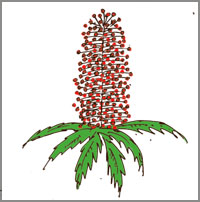
What the letters GNP stand for
 One
way of knowing or measuring a country's wealth is by its Gross National
Product (GNP). This is the total value of all the goods and services
produced in a country in a year, (it can also be identified as the Gross
Domestic Product) plus the foreign output claimed by residents of the
country. It is often called the national income. One
way of knowing or measuring a country's wealth is by its Gross National
Product (GNP). This is the total value of all the goods and services
produced in a country in a year, (it can also be identified as the Gross
Domestic Product) plus the foreign output claimed by residents of the
country. It is often called the national income.
In order to find the average income of a country's citizens (even
though it will not reflect how the wealth is distributed), you simply
divide the GNP by the population.
However, as the GNP of most countries is not based on correct
information, and as many developing countries have never had a complete
census (count of their population), even the average income one arrives
at is only a rough guide. So, the GNP figures are only a guide to a
country's national wealth.
What 'depressions' are
 You
must have often heard officials of the Meterological Department claiming
that the prevailing (existing) stormy weather conditions during certain
periods are due to a depression in the Bay of Bengal. You
must have often heard officials of the Meterological Department claiming
that the prevailing (existing) stormy weather conditions during certain
periods are due to a depression in the Bay of Bengal.
What exactly are these depressions? As the north and south poles are
always cold, the air that flows from these areas are cold while air that
flows towards the poles are always warm. This cold and warm air meet
along a line known as the polar front.
As you may already be aware, because of the great difference in
temperature, the cold and warm air do not mix. What happens then? The
warm air flows into bends in the polar front and cold air flows in
behind it. This sets up a rotating low pressure air system called a
depression or cyclone which has warm, light air at the centre.
The front edge of this warm air is called the warm front. Ahead of
this warm front the warm air flows upwards, over the dense (thick) cold
air. When it rises, a blanket of cloud forms and rain starts to fall
from it.
Meanwhile, the advancing edge of the cold air called the cold front
pushes cold air under the warm air. Thunder clouds often form as the
warm air rises. Depressions therefore bring stormy, unsettled weather as
they move across the land.
Which tree needs fire to reproduce
 We
have heard of plants reproducing with the help of insects, birds and of
course the wind, but, fire? Strange as it may seem, some plants need
fire to complete their life cycle. We
have heard of plants reproducing with the help of insects, birds and of
course the wind, but, fire? Strange as it may seem, some plants need
fire to complete their life cycle.
The Banksia trees, which grow in semi-desert regions of Australia,
are a plant species that need fire in order to reproduce. These plants
need a bush fire for their seeds to split open and germinate. The new
plants have a fiery birth.
The Banksia's striking and colourful flowers secrete honey, hence the
plant is also called the Australian honeysuckle tree.
How a snake can swallow huge prey
 It
is certainly amazing how some snakes swallow prey that are very much
bigger than themselves. The prey they eat are bigger and broader than
their narrow heads and bodies. It
is certainly amazing how some snakes swallow prey that are very much
bigger than themselves. The prey they eat are bigger and broader than
their narrow heads and bodies.
They can do this because their jaws are not rigidly fixed together;
they are merely connected by ligaments which can stretch, allowing the
snake to force its mouth right over the bulkiest of prey.
A snakes stomach too can stretch enormously and this allows the snake
to swallow its prey whole. Snake's that swallow eggs whole, have a
unique way of breaking them open once they are inside the bodies. They
have special bones in their throats which they squeeze against the eggs
until they break.
Which rodent is the largest in the world
 Most
rodents we are familiar with are quite small; small enough to sit on our
hands. The rats and mice we often see are not so big, are they? Well,
can you believe then that there is a rodent in the world that is almost
big enough for you to sit on? Most
rodents we are familiar with are quite small; small enough to sit on our
hands. The rats and mice we often see are not so big, are they? Well,
can you believe then that there is a rodent in the world that is almost
big enough for you to sit on?
The South American capybara can reach a size is 1.4 m (4 1/2 ft) and
a weight of 55 Kg (121 lb). Even larger species have been recorded in
captivity. The capybara usually spends much of its time submerged in
water. |
